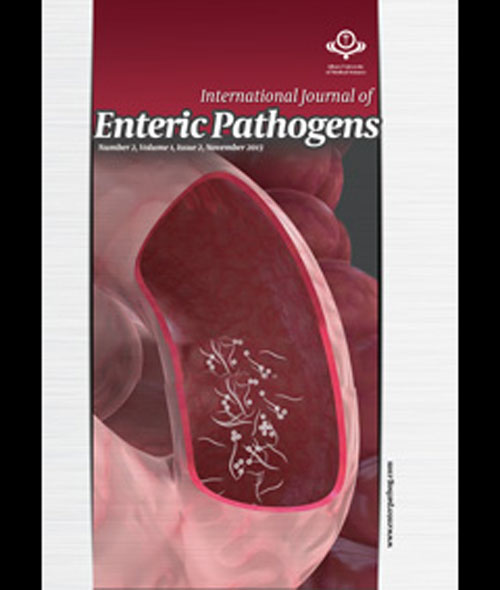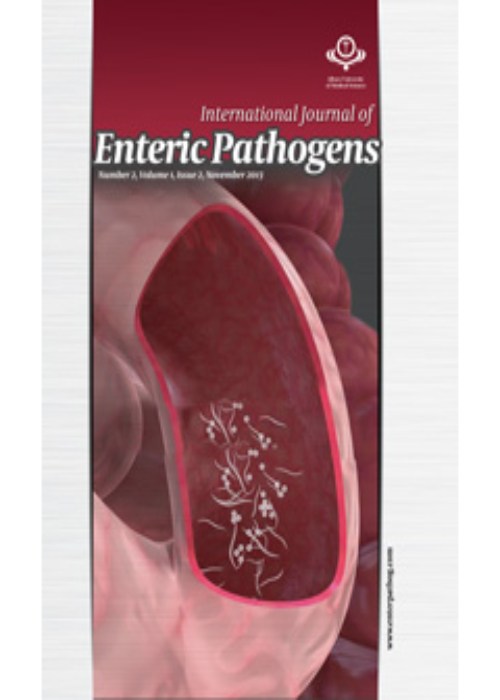فهرست مطالب

International Journal of Enteric Pathogens
Volume:6 Issue: 4, 2018 Nov
- تاریخ انتشار: 1397/08/22
- تعداد عناوین: 7
-
-
Pages 84-88
The present study aimed to provide an overview of epidemiology, pathogenicity, clinical diagnosis, and treatment of Candida esophagitis in human immunodeficiency virus (HIV)-infected patients. The review process involved studying all the existing literature published on this Candida infection. Esophageal candidiasis (EC) is the most common manifestation of mucosal candidiasis and patients with HIV are predominantly at the risk of this opportunistic infection. The prevalence of EC indicated diverse ranges among HIV patients in different geographic areas due to antiretroviral therapy (ART). The main factors for EC were gastric ulcers, CD4+cell count <200 cells/mL, and HIV viral load >400 cells/mL in the ART era. However, a low CD4+ cell count (<200 cells/mL) was significantly associated with EC in the pre-ART era. The interactions between the Candida virulence factor and host immune defense lead to the host responses against this fungal pathogen. During the Candida albicans invasion, secretion of candidalysin which is encoded by the hyphal gene ECE1 has a potential role in epithelial cell damage and secretion of stimulated cytokine. Early trials of the empirical antifungal therapy are recommended before an endoscopic examination. Esophageal biopsy should be considered in patients with a failure of empiric antifungal treatment as it may allow the possibility of drug-resistant Candida and other opportunistic pathogens. The first-line induction treatment of Candida esophagitis is based on oral fluconazole. The shift from C. albicans to non-albicans Candida (NAC) may be correlated with the development of fluconazole resistance and relapse or therapeutic failure in this infection. An increase in the intrinsic and acquired resistance has raised the significance of the optimal antifungal therapy for the critically ill patient. Candida esophagitis requires a systematic suspicion for early diagnosis and appropriate management of HIV infected patients in order to prevent delayed treatment related to undesirable morbidity or even mortality scores.Keywords: HIV infection, Human immunodeficiency virus, Candida species, Esophageal candidiasis -
Pages 89-94BackgroundTyphoid fever caused by Salmonella typhi is endemic in many developing countries.ObjectiveThis study aimed to investigate the prevalence of S. typhi in patients attending secondary health centers within the 9 local government areas (LGAs) of Benue.Materials and MethodsA total of 1022 stool samples, from 583 (57.0%) males and 439 (43.0%) females were collected from patients diagnosed using Widal reaction between August 2016 and July 2017. Selenite broth, Salmonella-Shigella agar, Xylose Lysine Deoxycholate agar and Bismuth Sulfite agar were used for isolation. S. typhi was identified using cultural and biochemical characteristics. Univariate analysis and multivariate logistic regression were performed to analyze the collated data.ResultsA high prevalence of S. typhi (43.7%, n = 447) and significant differences were observed (P < 0.05) in the study site, age, sex and month of sampling. Oju LGA accounted for the highest rate, 64.2% (n = 123). S. typhi infection was highest in patients aged ≤10 years (52.7%, n = 243). Males had a significantly higher isolation frequency of 46.8% (adjusted odds ratio [AOR] = 1.321, CI = 1.027–1.700) than females (39.6%). Isolation rates were higher between January (50.0%, n = 31) and May (61.8%, n = 76). Some Widal positive samples were negative for S. typhi upon culturing.ConclusionThese findings suggest the existence of a significant public health hazard which can negatively affect the livelihood of rural dwellers. There is a need for a review of the approach to the diagnoses of typhoid fever in the study area. Increased efforts at sanitation and personal hygiene are advocated.Keywords: Salmonella, Infection, Prevalence, Seasonal variation, Resistance, Typhoid
-
Pages 95-103BackgroundFood products need to be protected against pathogenic and non-pathogenic microorganisms. One method is adding antimicrobial agents. Consumers’ tendency to use synthetic additives is drastically decreasing due to their side effects and also the emergence of multidrug resistant microorganisms. Plant essential oils (EOs) are natural antimicrobial compounds which are widely used in food industry.ObjectiveThe objectives were to determine the chemical compositions of Caryophyllus aromaticus and Origanum majorana EOs and also to assess their antimicrobial activities against foodborne bacteria alone and in combination.Materials and MethodsThe EOs were analyzed by gas chromatography-mass spectrometry. Antibacterial activities of the EOs against foodborne bacteria were assessed using disc diffusion method. The minimum inhibitory concentration (MIC) values of the EOs were determined by microdilution broth method and then minimum bactericidal concentration (MBC) values were determined. Checkerboard synergy testing was performed to determine the fractional inhibitory concentration index. Then time-kill curves were drawn based on the bacterial population (CFU/mL) against time (h).ResultsThe major constituents of C. aromaticus were eugenol and carvacrol, while O. majorana had carvacrol, thymol, trans-caryophyllene, and cymene as the main constituents. Zone of inhibition for O. majorana EO was greater than that for C. aromaticus EO. The inhibition zone of O. majorana EO against all the tested bacteria except for Bacillus subtilis was significantly greater than that of streptomycin (P 0.05). MIC value of the EOs against bacteria was 0.1% except for O. majorana EO against B. subtilis (0.3%). MBC values of C. aromaticus and O. majorana EOs ranged from 0.5% to 1.0% and 0.3% to 0.5% (v/v), respectively. The EOs were more effective on gram-positive bacteria than gram-negative ones. The combination of EOs revealed synergistic activity against Listeria monocytogenes, partial synergistic activity against B. subtilis, and additive effect against Salmonella typhimurium, Escherichia coli O157:H7 and Staphylococcus aureus were indifferent against the combination of EOs. Time–kill curves of the EOs demonstrated strong bactericidal effect against all foodborne bacteria at 6 and 24 hours either alone or in combination.ConclusionThe synergistic, partial synergistic, and additive effects of the combination of C. aromaticus and O. majorana EOs strengthen the antimicrobial activity, expand the spectrum of activity, reduce the concentrations required, decrease the side effects, and prevent the alteration of organoleptic properties of food.Keywords: Antimicrobial efficacy, Chemical properties, Caryophyllus aromaticus, Origanum majorana, Essential oils, Foodborne bacteria
-
Pages 104-107BackgroundUrinary tract infection (UTI) is one of the most common diseases in all the age categories around the world.ObjectiveThe current study aimed to investigate the presence and expression of the stx1 gene in Escherichia coli isolated from women with UTI in Tabriz.Materials and MethodsIn this descriptive cross-sectional study, 25 E. coli isolates were assessed for the presence of the stx1 gene by polymerase chain reaction (PCR) method after DNA extraction. Then, they were evaluated in terms of stx1 gene expression by the real-time PCR.ResultsSix (24%) out of 25 tested E. coli isolates harbored stx1 gene. In addition, 2 samples out of these 6 isolates containing the stx1 gene showed more gene expression compared to the control samples.ConclusionBased on the prevalence of UTI with E. coli among the community and diffusion of its pathogenesis factors, fast and accurate identification of E. coli and its resistance factors is necessary for curring this infectionKeywords: Urinary tract infection, Escherichia coli, stx1 gene, Real-time PCR
-
Pages 108-112BackgroundEosinophils dysregulate immune responses associated with malignancies, allergic and parasitic diseases especially helminthic infections, though it is infrequently observed with protozoan diseases.ObjectiveThe aim of the present study was to evaluate and compare the percentage of eosinophils in different parasitic diseases at Baqiyatallah Hospital, Tehran, Iran.Materials and MethodsOne hundred and 72 samples were obtained from 74 and 98 patients with helminthic and protozoan diseases respectively and evaluated. Direct wet mount and formalin ether concentration were used for intestinal parasites identification. Scotch tape test and serological methods were utilized for diagnosis of Enterobius vermicularis and tissue parasites respectively. Eosinophils were counted and six or more percentages were considered as eosinophilia.ResultsIn general, in 34 out of 74 helminthic infections (45.9%) and 5 out of 98 protozoan infections (5.1%), an eosinophil level equal or more than 6% was observed. The rate of eosinophilia in helminthic infections were 13/18 (72.2%), 7/11 (63.6%), 3/10 (30%), 2/3 (66.7%), 1/9 (11.11%), 5/13 (38.5%), 3/4 (75%) in the patients with fasciolosis, strongyloidiasis, hymenolepiasis, hookworm infection, enterobiasis, echinococcosis, and trichostrongyliasis, respectively. Concerning the protozoan infections, 3/26(11.5%) and 2/20(10%) of the individuals suffering from giardiasis and blastocystosis showed an eosinophil level higher than normal range, respectively.ConclusionAs expected, helminthic infections especially fasciolosis and strongyloidiasis were the most important infections correlated with eosinophilia. According to available reports, eosinophilia higher than normal range in giardiasis and blastocystosis is not unexpectedKeywords: Eosinophilia, Parasitic infections, Baqiyatallah Hospital
-
Pages 113-117BackgroundTherapeutic applications of probiotics against human candida infections remain controversial. Candida species are the most common human fungal pathogens that cause both superficial and systemic infection. Given the low number of appropriate and effective antifungal drugs, the continuing increase in the incidence of Candida infections, and increased drug resistance, it is required to explore new and better factors targeting essential biological processes and pathogenic determinants of C. albicans.ObjectiveIn this context, a laboratory study was conducted to investigate the effects of probiotic Lactobacillus acidophilus on the adherence of C. albicans to the human epithelial cell line known as human epithelial type 2 (HEp-2) cells and the potential protective effects of probiotic bacteria on the infected cells.Materials and MethodsTo evaluate the effect of L. acidophilus on the adherence of C. albicans to HEp-2 cells, either yeast cells, probiotic bacteria, or both were added to each well of a 12-well plate, with a coverslip at the bottom, covered with a semiconfluent layer of HEp-2 cells. After 2 hours of incubation, the number of adhered pathogens was counted using light microscopy. In order to determine the effect of C. albicans on the viability of the HEp-2 cells, in the presence and absence of L. acidophilus, MTT (3-(4,5-dimethylthiazolyl-2)-2,5-diphenyltetrazolium bromide) assay was conducted.ResultsThe results revealed that either L. acidophilus strain La5 or C. albicans adhered to the (HEp-2) cells. In addition, cell association of C. albicans with Hep2 cells decreased by up to 80% when probiotic bacteria were added. The most interesting finding was that in the presence of L. acidophilus La-5, a significant decrease was observed in the adhesion of C. albicans to the cell line or cell mortality.ConclusionAccording to the results of the study, the use of probiotics is a promising method to decrease the pathogenicity of opportunistic mycosesKeywords: Candida albicans, Probiotic, Lactobacillus acidophilus, Adherence, Cell line, MeSH


